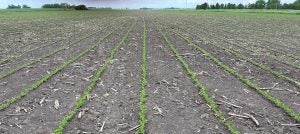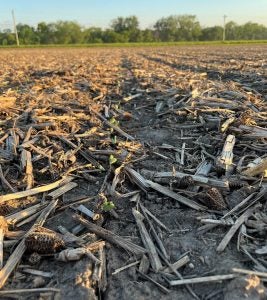Crop safety in soybeans and other commodity products has become an increasing focus for growers who find themselves planting earlier in the season, often on the lower end of seeding rates with cool and wet weather still a wildcard. Their need to not set the crop back in the early stages and to get to canopy closure more quickly drives the urgency of those crop-safety conversations.
In addition to helping soybeans gain an advantage over weeds due to an earlier canopy, modern crop protection chemistries that highlight crop safety are creating opportunities for better plant stands, healthier root mass, and greener leaf tissue once the crop emerges.
The resulting robust plant populations translate into better yields in the fall.
“It’s a race to canopy closure, and you’ll get there first with a healthier crop,” said Eric Palmer, Herbicide Technical Product Lead for Syngenta. “Growers are really seeing a yield benefit from good crop safety by carefully selecting herbicides that do not set the crop back a couple of weeks and using them early in the season before weed emergence.”

Palmer has worked closely with the preemergence soybean herbicide Tendovo®, which was registered by the U.S. Environmental Protection Agency in January 2022 and will be commercially available for the 2023 growing season. Tendovo had been in trials for a couple of years before being used by select growers throughout 2022 as part of Syngenta’s Tendovo First Look Program.
The key feedback from growers in that program was overwhelmingly about Tendovo herbicide’s crop safety benefits — they weren’t seeing stunting, stand loss, or phytotoxicity on the leaf tissue. Especially when used in conjunction with a high-quality seed treatment, like CruiserMaxx® APX or Saltro®, high-value crop-safety chemistries such as Tendovo are resonating.
“The crop comes out of the ground growing rapidly, and growers have been really impressed with that,” Palmer noted.
But some experts note that crop safety can be a difficult topic to convey, even if the fundamentals are on every grower’s mind.
“If you do a split-field trial, with Tendovo on Field A and another product on Field B, it works perfectly because you can see the Tendovo side coming out of the ground growing green, growing healthy, whereas the other side may have more damage or more necrosis,” said Andrew Thilges, Regional Sales Agronomist with Minnesota-based retailer Central Farm Service. “That’s when you see a big ROI response.”
After all, if you lose half your stand or encounter discoloration or malformation of the leaves or stems, that’s when an ROI impact will start to reveal itself.

Kevin Scholl, an agronomist who has worked at Syngenta since 2005, said most growers aren’t willing to split their fields, so they don’t see how an herbicide that zeroes in on crop safety performs directly against one that doesn’t.
“It’s hard to show a return on investment because you don’t really have a comparison within the same field to make that judgment,” Scholl explained.
Palmer noted that while crop injury varies year-to-year, it has been common for growers to encounter 8 percent to 20 percent injury in previous seasons, with some worst-case scenarios contributing to more than 50 percent injury if the environmental conditions aren’t favorable.
And harsh weather can impact any part of the country.
“I’ve seen it where we’ve had late cool snaps in the South, and I’ve certainly seen snow after we’ve planted crops in the North,” said Palmer, who’s been with Syngenta for about two decades.
Some of his recent work has involved summarizing over three years’ worth of data on Tendovo, including its yield and instances of crop injury.
“All of the data I’ve looked at with Tendovo have been very safe on soybeans, typically less than about 5 percent crop injury,” he said. “In research, we consider 10 percent injury to be the upper end of acceptability benchmark, but the long-term data have shown it to be much better than that.”
He noted that Tendovo herbicide’s performance and crop safety has helped to redefine preemergence weed control and can expand the early post-application window for coming back and overlapping residuals for full-season weed control, which can contribute to yield improvements. In university trials, Tendovo herbicide helped increase potential yield by 4 to 5 bushels per acre compared to competitive herbicide brands1.
And as lower seeding rates push soybean populations downward, it becomes more important not to allow for any stand loss and for growers to position themselves better before harvest arrives.
“Early season, the more vigorous plant you have, the more nodes on that plant and the more that will be on at the end of the season,” Scholl said. “More nodes equals more pods equals more beans. So that’s where we get more yield.”
Thilges has seen first-hand that Tendovo is a very crop-safe herbicide and one that he feels comfortable putting in front of any post-herbicide plan.
“I had Tendovo on a couple of hundred acres,” Thilges said. “We had a perfect stand in that field. Everything came out of the ground very well, and we didn’t see any damage from the pre-herbicide.”
Tendovo succeeds by combining three sites of action and three active ingredients, and when label directions are followed, crops are ideally positioned to avoid damage.
“The premix has given me the confidence to say that this is one of the safest products we can use,” Thilges said. “I’m not worried about it, so you shouldn’t be either, growers.”
To view real-world performance from a field near you, visit Syngenta-us.com/SeeTendovoInAction.
This article was published on behalf of Syngenta. Visit this page to find a Syngenta Crop Protection Specialist near you.
Ryan Tipps is the founder and managing editor of AGDAILY. He has covered farming since 2011, and his writing has been honored by state- and national-level agricultural organizations.



